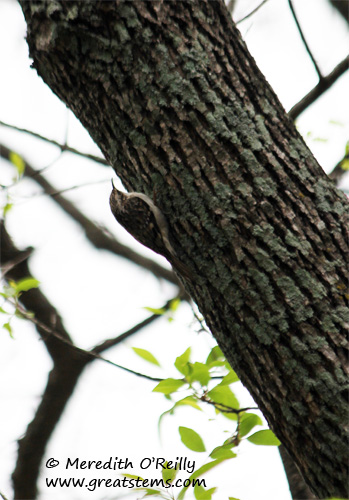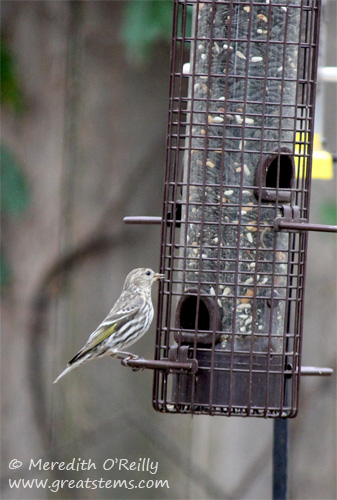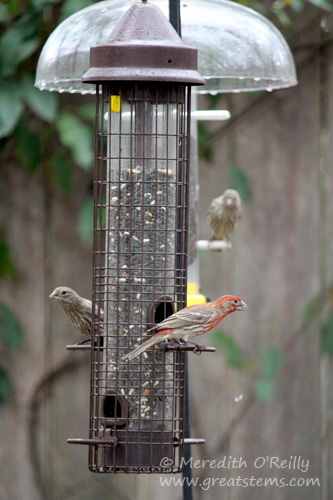It was time for the annual clean-the-muck-out-of-the-pond event. Oak leaves, acorns, twigs, and natural pond ick gather at the bottom over the course of the year, so each spring I get in the pond and clean it out (leaving a little sediment to keep the bacteria levels balanced). As I was making preparations, Michael came in and warned me that a rather loud splash as he walked by the pond might indicate that I might not be alone in said body of water while doing maintenance. In fact, I might just get eaten. Frog, I assumed. Given the splash, probably another American Bullfrog. And while I was correct, what I could not have predicted was that this frog would be as big as a planet. Well, almost.

It’s a little intimidating as the water level lowers in the pond (with you in it), knowing that at some point a fish, frog, or other critter is going to wiggle, squirm, jump, slide, or dart past you. After a while, the water was low enough that I could more easily get some of the oak leaves and other natural debris out, and I knew that meant I would soon encounter the creature. I intended to do my best not to squeal, shriek, or scream, the automatic reaction to things moving fast in the murky waters surrounding me. But when not just one but two frogs started jumping in opposite directions from the muck and then ping-ponging around the pond up, over, and under my legs, the squeals just naturally came. I couldn’t help it.
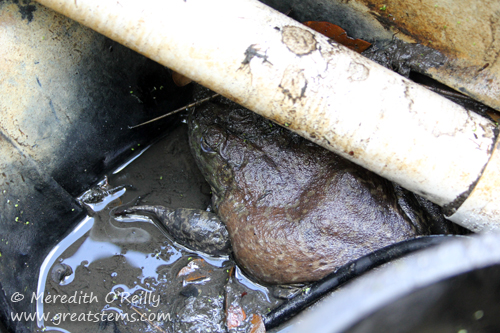 Eventually I got back to work, lowering the pond level more and rediscovering one of the frogs in the muck. Her belly, brown and rather alien-like, was what I noticed, and it’s what I gingerly had touched before when the frog ping-pong thing had happened. I wasn’t going to fall for it again. I KNEW that was the frog. What I did do was use the water to rinse enough of the muck away to at least find her head… and was that monstrous leg hers, too? Holy frog-moly, I thought. She’s huge.
Eventually I got back to work, lowering the pond level more and rediscovering one of the frogs in the muck. Her belly, brown and rather alien-like, was what I noticed, and it’s what I gingerly had touched before when the frog ping-pong thing had happened. I wasn’t going to fall for it again. I KNEW that was the frog. What I did do was use the water to rinse enough of the muck away to at least find her head… and was that monstrous leg hers, too? Holy frog-moly, I thought. She’s huge.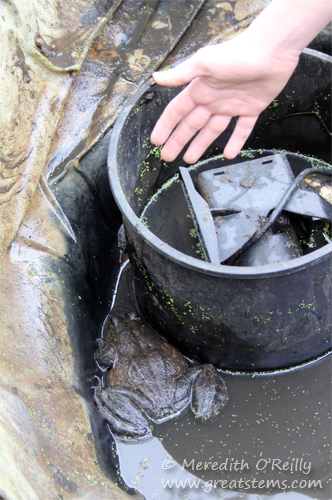
And so the preparations for capture began. Nolan decided that he wanted the job, which was good because I could then get out and clean up enough to take pictures of the process. During the time the pond was temporarily human-less, the second frog managed to escape from the pond, and Big Momma at least managed to get herself out from under the pipe, which would make it much easier for us to get her out of the pond.
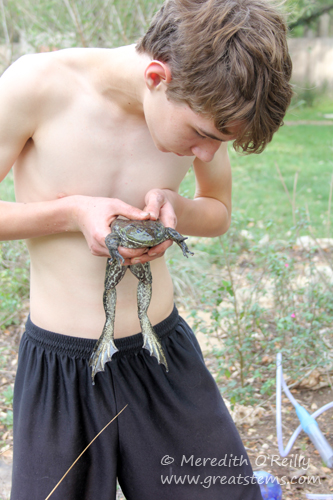
Fortunately, the big girl stayed calm while Nolan carefully collected her from the pond.
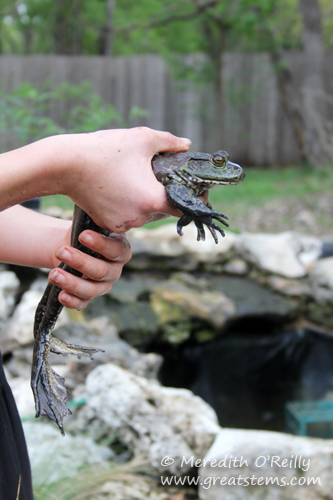
She definitely is larger than our former record-holder, Frogzilla. With a body length of about 8 inches (and crazy-long legs), she has now been dubbed The Behemoth, champion of whatever Great Stems frog contest this is. Really, she wins them all. Even the beauty contests, perhaps, but only if the pond muck gets washed off first.
Even the beauty contests, perhaps, but only if the pond muck gets washed off first.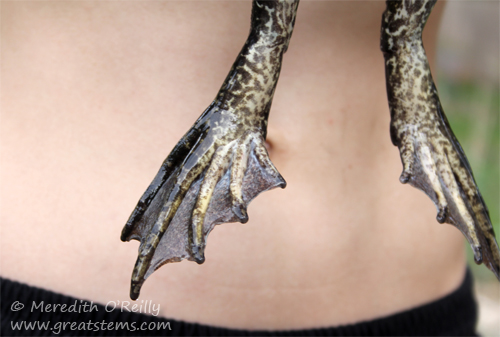
As much as we adore frogs, we’ve learned that American Bullfrogs are just too big for our hot-tub pond. They drive away the smaller native frogs (or worse, eat them). And they are capable of eating birds that come down to bathe and drink in the shallow areas of the pond. So during maintenance, if we have a chance to relocate a bullfrog, we do so.
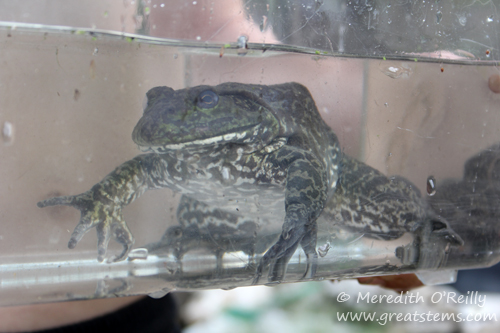
There is a very large pond just beyond our neighborhood, and we expect it’s the pond she originally came from. And so that’s where we returned her to.
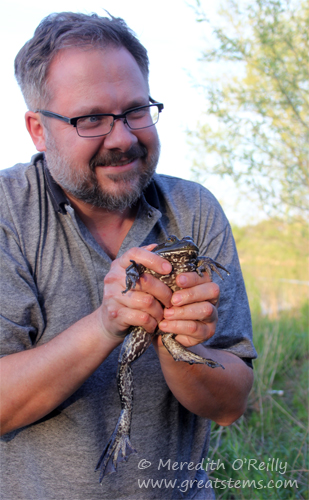
We invited our friend Stepan to join us for her release. In fact, we gave him the honor of helping her to her new home. She didn’t eat him either. But she could have.

Here she calmly waits for a few more pictures, by her new (and/or former) pond.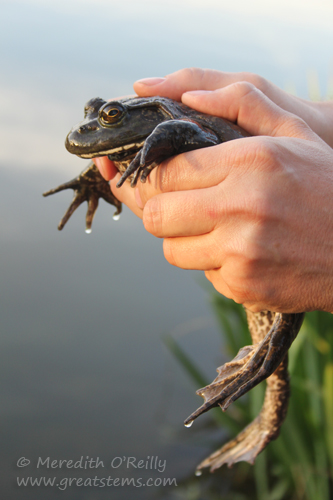

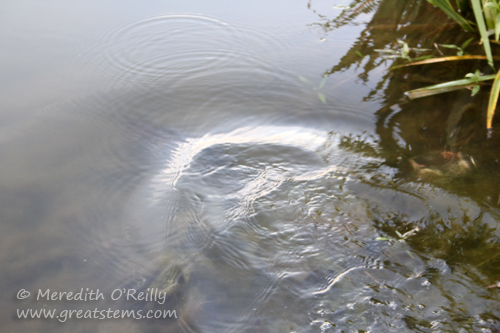 And there she went. I guess now she’ll be a small frog in a big pond, instead of the head honcho of a small pond, but somehow I think she’ll be happier. Our fish and birds will be happier, too.
And there she went. I guess now she’ll be a small frog in a big pond, instead of the head honcho of a small pond, but somehow I think she’ll be happier. Our fish and birds will be happier, too.
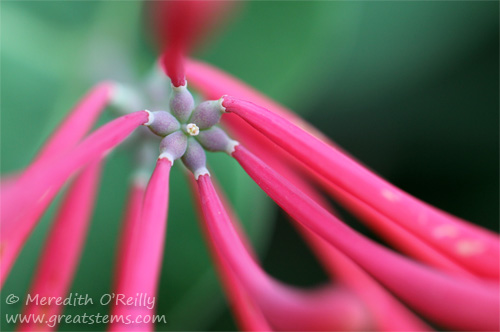
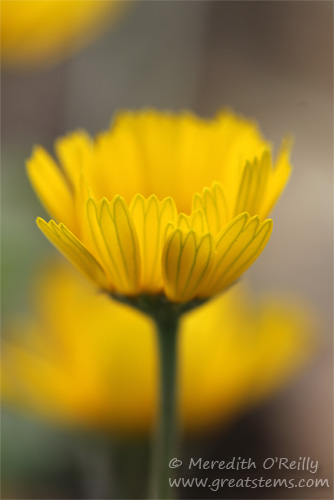
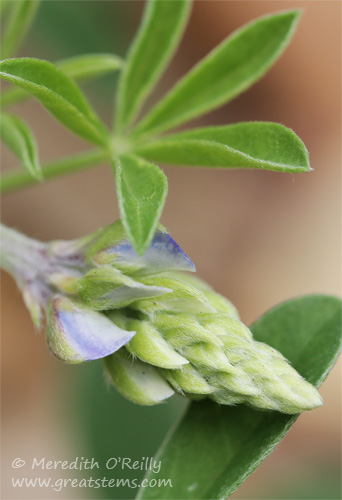
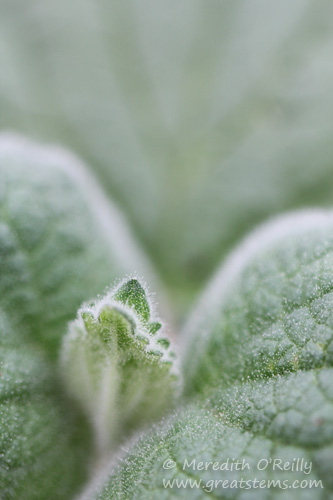
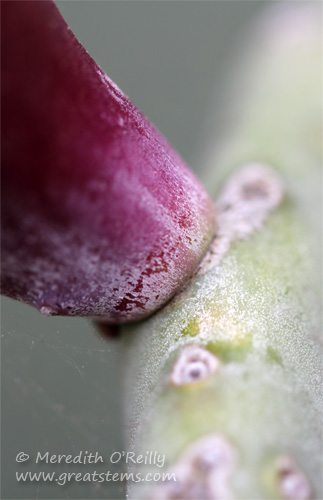
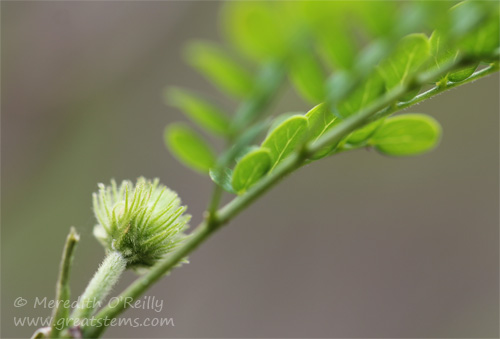
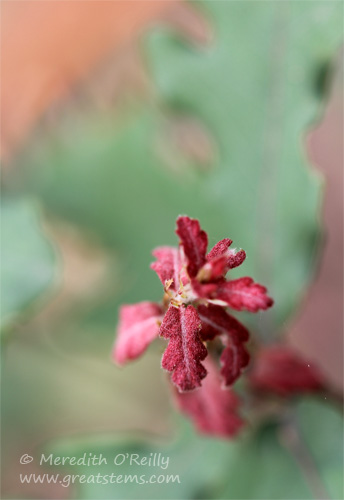

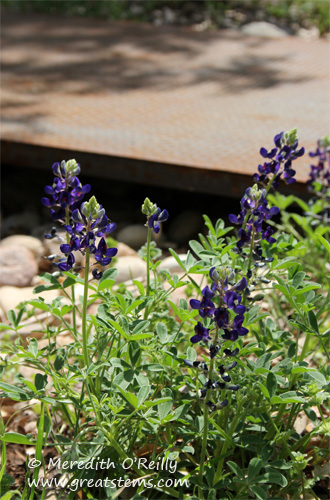 Out by the new
Out by the new  In the backyard, the Coral Honeysuckle is so dense and tall that I think this year it will finally spill over the fence.
In the backyard, the Coral Honeysuckle is so dense and tall that I think this year it will finally spill over the fence. 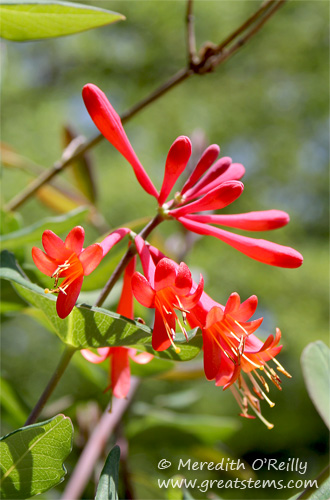 Hopefully my neighbor will enjoy the blooms — he loves color in the garden.
Hopefully my neighbor will enjoy the blooms — he loves color in the garden.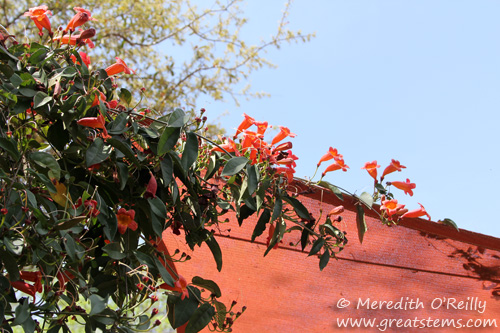 The Crossvine near the backyard shade sails is heavy with blooms (there were even more blooms a couple of days ago, but in typical fashion I forgot to put the memory card in the camera when I took pics that day — alas). We love the creeping vines and blooms working their way along the edge of the sails.
The Crossvine near the backyard shade sails is heavy with blooms (there were even more blooms a couple of days ago, but in typical fashion I forgot to put the memory card in the camera when I took pics that day — alas). We love the creeping vines and blooms working their way along the edge of the sails.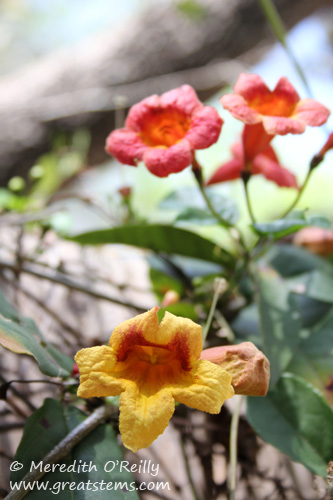 But here’s a mystery — over in the shade my original Crossvine plant, the native yellow-exterior variety, is doing something odd. Part of it is blooming yellow as expected, but the same plant is simultaneously producing orange-exterior blooms. What on earth is going on? There hasn’t been any change to the soil, but we did have a very mild winter — is it a temperature thing? I don’t want to lose my yellow blooms — they are my favorite! I’m trying not to feel alarmed, but I can’t help it!
But here’s a mystery — over in the shade my original Crossvine plant, the native yellow-exterior variety, is doing something odd. Part of it is blooming yellow as expected, but the same plant is simultaneously producing orange-exterior blooms. What on earth is going on? There hasn’t been any change to the soil, but we did have a very mild winter — is it a temperature thing? I don’t want to lose my yellow blooms — they are my favorite! I’m trying not to feel alarmed, but I can’t help it!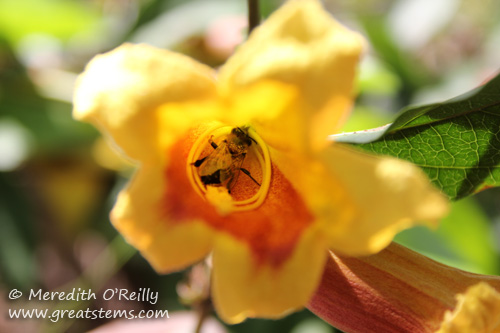 The honeybees don’t seem to mind the change — they visit the yellow and orange blooms with equal interest.
The honeybees don’t seem to mind the change — they visit the yellow and orange blooms with equal interest. This year, I’m excited to see my Golden Groundsel blooming for the first time. Let’s hope it reseeds and makes babies.
This year, I’m excited to see my Golden Groundsel blooming for the first time. Let’s hope it reseeds and makes babies.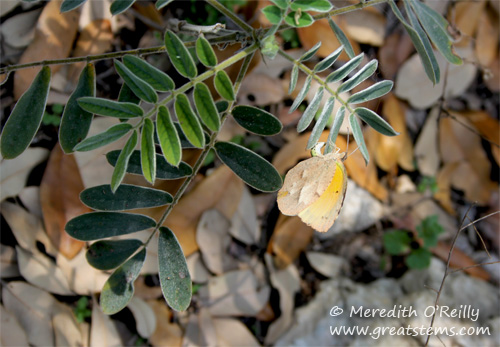 Sulphur butterflies, several species of them, have been busy laying eggs all over the Lindheimer’s Senna, which has barely had a chance to really show its spring face. But that’s par for the course — it’s the host plant for many Sulphur species, such as Sleepy Orange, Cloudless, Southern Dogface, Large Orange, and others. Eggs dot the tops and bottoms of the leaves — I can’t wait to see the caterpillars. I’m not worried about the number — I’ve got plenty of Lindheimer’s Senna to go around. I’ve never seen this many Sulphurs in the yard — can you guess how much I’m loving it? Lots!
Sulphur butterflies, several species of them, have been busy laying eggs all over the Lindheimer’s Senna, which has barely had a chance to really show its spring face. But that’s par for the course — it’s the host plant for many Sulphur species, such as Sleepy Orange, Cloudless, Southern Dogface, Large Orange, and others. Eggs dot the tops and bottoms of the leaves — I can’t wait to see the caterpillars. I’m not worried about the number — I’ve got plenty of Lindheimer’s Senna to go around. I’ve never seen this many Sulphurs in the yard — can you guess how much I’m loving it? Lots! Gray Hairstreaks are visiting the garden, as well — this one on Rose Pavonia. Every time I see one, I think about how
Gray Hairstreaks are visiting the garden, as well — this one on Rose Pavonia. Every time I see one, I think about how 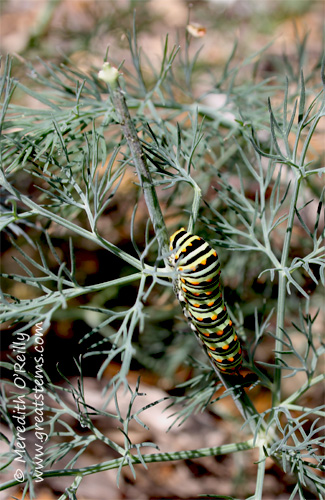 I was thrilled to discover that our dill and fennel are covered in Black Swallowtail caterpillars. In the fall I decided to be brave and plant the dill in one of the main garden beds, deciding that I’d be okay if it reseeds to abundance (the fennel is in its own container). Given my delight over the caterpillars, I feel confident that I made the right choice. But of course, we’ll see how much dill shows up next year!
I was thrilled to discover that our dill and fennel are covered in Black Swallowtail caterpillars. In the fall I decided to be brave and plant the dill in one of the main garden beds, deciding that I’d be okay if it reseeds to abundance (the fennel is in its own container). Given my delight over the caterpillars, I feel confident that I made the right choice. But of course, we’ll see how much dill shows up next year!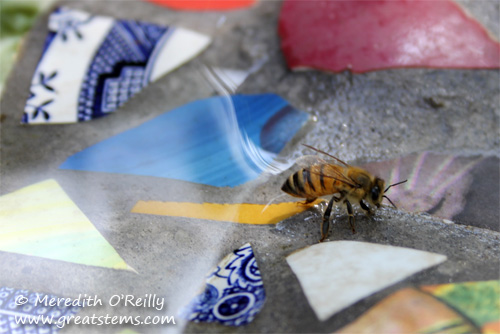 The mosaic birdbath is popular, and not just with birds. Squirrels and bees visit it, too — and who knows what else. It was fascinating watching the bees today — some collected water by skimming over the surface for a quick drink, but others preferred to stand on the side and drink safely at their leisure.
The mosaic birdbath is popular, and not just with birds. Squirrels and bees visit it, too — and who knows what else. It was fascinating watching the bees today — some collected water by skimming over the surface for a quick drink, but others preferred to stand on the side and drink safely at their leisure.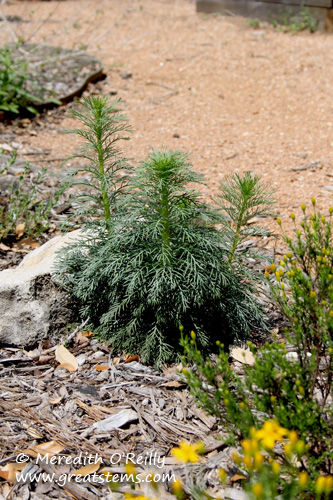 I’ve got many Standing Cypress plants now in their second year, and the flower spikes are already on their way up. They will grow big and tall by the time they are ready to show their vibrant red flowers — which the hummingbirds will go crazy for!
I’ve got many Standing Cypress plants now in their second year, and the flower spikes are already on their way up. They will grow big and tall by the time they are ready to show their vibrant red flowers — which the hummingbirds will go crazy for!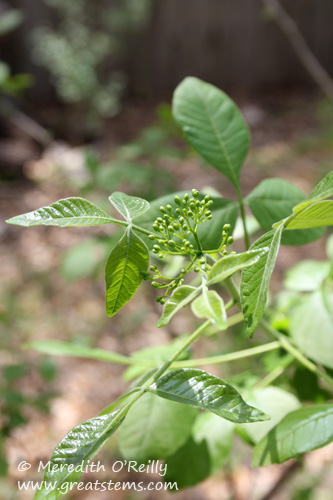 The Wafer Ash is even closer to blooming. With luck, I’ll actually see the flowers this year (usually they are sneaky, and the blooms come and go before I notice).
The Wafer Ash is even closer to blooming. With luck, I’ll actually see the flowers this year (usually they are sneaky, and the blooms come and go before I notice).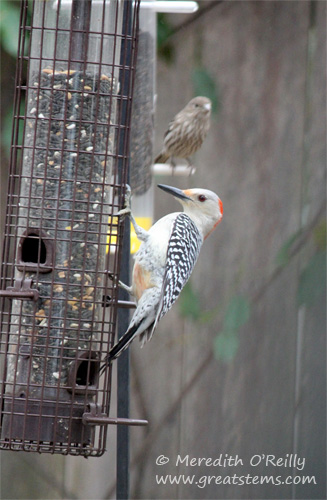
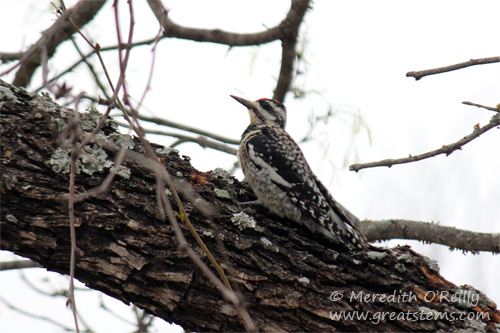
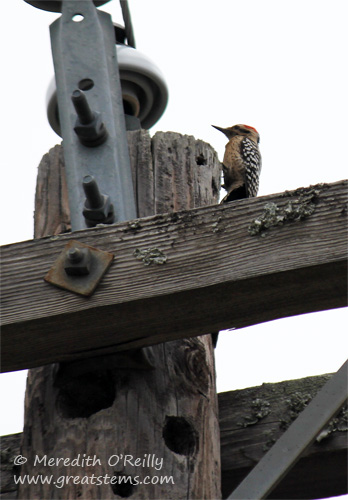
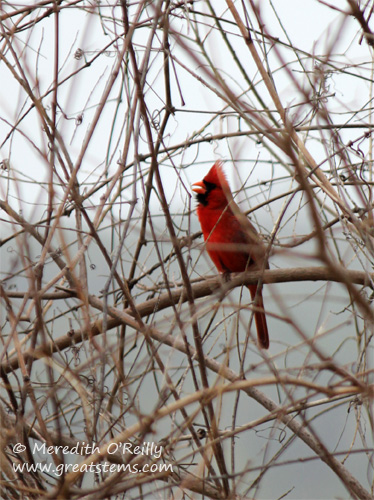 Not to be ignored, this Northern Cardinal was singing his heart out. He and a few other male cardinals were quite feisty today. Gee, does nesting season approach?
Not to be ignored, this Northern Cardinal was singing his heart out. He and a few other male cardinals were quite feisty today. Gee, does nesting season approach?
